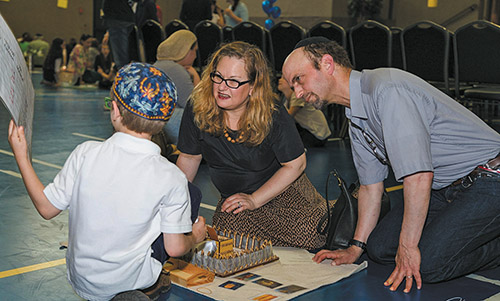

It was a sunny Lag B’Omer day as parents and grandparents of Yeshivat Netivot students filed into the school building in East Brunswick, New Jersey. That day the tables were turned. Elementary age students from six to nine years old taught the adults lessons on different subjects using the innovative Montessori method.
This unique method of education was developed by an Italian doctor, Maria Montessori, in the beginning of the 20th century. Using her observations and experiences working with children, she continuously modified her method—from teacher behavior and classroom environment to furniture, tools and lessons—to meet the needs of the “whole child.” When Dr. Montessori said, “Follow the child, but follow the child as his leader,” she was advocating the wisdom of Shlomo HaMelech. Today, there are several Jewish Montessori elementary schools implementing the directive of “Chanoch l’naar al pi darko.”
At Yeshivat Netivot, parents fanned out towards their children, who patiently waited in the four different sections of the room: Chumash and Ivrit, Cultural, Math and Language Arts. Each student or pair of students had work rugs laid out in front of them. On each rug, lesson materials were organized neatly.
In the Chumash & Ivrit section, David, a first grader, introduced himself and informed the adults that he would be presenting the “KeLeV” Rule Lesson, prefacing, “It is not a dog!” Using Aleph-Bet, nekudot, and Hebrew noun cards, he proceeded to explain the role of the prefixes Kaf, Lamed and Vet in front of a noun.
His mother Margalit said after the event, “I was very impressed by the breadth of the materials covered by the children, by their understanding, and their ability to teach it to other people. The teachers were there to support them, and the children were very comfortable interacting with the adults.”
A few rugs over, in the Cultural section, Bryan, a second-grader, introduced himself and his lesson on the Mishkan. In front of him sat a beautiful 3D model of the Mishkan, complete with miniature wooden rings and poles to hold outer and inner curtains. The Torah came alive as Bryan explained the purpose of the Mishkan and its different parts. Parents admiringly examined its pieces.
Bryan’s mother Rebecca Strub said of the lesson, “…. I love that the kids here get to experience their learning in tangible ways. Until today I did not have a mental model of the Mishkan.”
Nearby, Jake Zucker-Levine, a third-grader, gave a lesson on the planets. He compared the planets to various size fruits which were displayed there to illustrate his point. Jake ended his lesson by inviting his audience to ask questions.
Every demonstrated lesson, or “work” as it is referred to in Montessori terminology, had concrete materials that could be manipulated by the presenter and the audience. This is the manner in which elementary students are taught throughout the year. Each day, students consult their “work journals”—a weekly list of works in each area of Limudei Kodesh and secular studies—and decide what they will complete first. It is a unique approach to education that engenders responsibility.
Elementary Limudei Kodesh educator, Naama Raanan noted that the projects “made the [children] feel so proud of themselves, [gave] them so much confidence.”
The event concluded with the presentation of the next year’s sefarim: the first graders received siddurim, the second graders Chumashim, and the third-graders Nevi’im.
By Zita Weinstein










